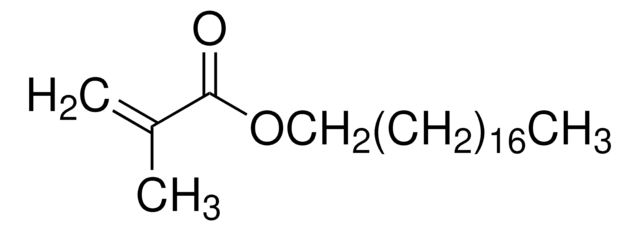291811
Lauryl methacrylate
contains 500 ppm MEHQ as inhibitor, 96%
Sinónimos:
Dodecyl 2-methyl-2-propenoate, Dodecyl methacrylate
About This Item
Productos recomendados
Quality Level
assay
96%
contains
500 ppm MEHQ as inhibitor
refractive index
n20/D 1.445 (lit.)
bp
142 °C/4 mmHg (lit.)
mp
−7 °C (lit.)
density
0.868 g/mL at 25 °C (lit.)
SMILES string
CCCCCCCCCCCCOC(=O)C(C)=C
InChI
1S/C16H30O2/c1-4-5-6-7-8-9-10-11-12-13-14-18-16(17)15(2)3/h2,4-14H2,1,3H3
InChI key
GMSCBRSQMRDRCD-UHFFFAOYSA-N
¿Está buscando productos similares? Visita Guía de comparación de productos
Categorías relacionadas
General description
Application
- To prepare polymeric co-stabilizer by free-radical copolymerization.
- To fabricate fluorine-less superhydrophobic cotton fabrics via graft polymerization process.
- In the synthesis of prepolymers that are used in oil absorbents.
signalword
Warning
hcodes
Hazard Classifications
Aquatic Acute 1 - Aquatic Chronic 1 - Eye Irrit. 2 - Skin Irrit. 2 - STOT SE 3
target_organs
Respiratory system
Storage Class
10 - Combustible liquids
wgk_germany
WGK 1
flash_point_f
224.6 °F - closed cup
flash_point_c
107 °C - closed cup
ppe
Eyeshields, Gloves, type ABEK (EN14387) respirator filter
Elija entre una de las versiones más recientes:
¿Ya tiene este producto?
Encuentre la documentación para los productos que ha comprado recientemente en la Biblioteca de documentos.
Los clientes también vieron
Nuestro equipo de científicos tiene experiencia en todas las áreas de investigación: Ciencias de la vida, Ciencia de los materiales, Síntesis química, Cromatografía, Analítica y muchas otras.
Póngase en contacto con el Servicio técnico











